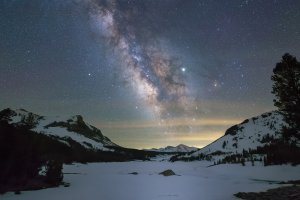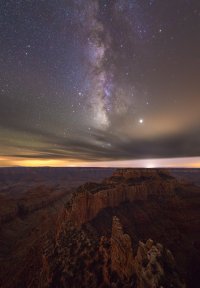You are using an out of date browser. It may not display this or other websites correctly.
You should upgrade or use an alternative browser.
You should upgrade or use an alternative browser.
Milky Way
- Thread starter tpatana
- Start date
Attempted this last year but the tide was high so was not able to get close to the rock; perfect conditions this time around
 The Dolphin and the Stars by Tony, on Flickr
The Dolphin and the Stars by Tony, on Flickr
Quite happy with the amount of Milky Way detail I was able to extract from Bortle 4 light pollution
 The Dolphin and the Stars by Tony, on Flickr
The Dolphin and the Stars by Tony, on FlickrQuite happy with the amount of Milky Way detail I was able to extract from Bortle 4 light pollution
Upvote
0
Here's one of my favorites from last fall on the North Rim of the Grand Canyon. I shot 20 images of the foreground to stack for noise reduction then shot a single tracked exposure of the Milky Way. Blended the two resulting images in Photoshop using a simple layer mask.
I was disappointed that I didn't have clear skies but now I think they really add to the image.
I was disappointed that I didn't have clear skies but now I think they really add to the image.
Attachments
Upvote
0
There's definitely an art to processing Milky Way shots. First, shot the core. It rises about midnight right now in the northern hemisphere. Make sure it's properly exposed (base exposure is 30s f2.8 ISO 3200). Adjust exposure and contrast as needed in Lightroom. Boost vibrance and saturation as needed. Ensure proper white balance, for my 6D that's usually about 4000K with +6 tint. But white balance is subjective and will depend on location due to light pollution.Love the photo that was with the first post on this thread.. been trying to do something like that but my photos always look..boring? Just the stars and lots of grey.. I get the general settings but am I missing something? How did you get the blue??
There are some great tutorials on Youtube from photographers such as Ian Norman (Lonely Speck), Michael Shainblum, and Chris Ewen Crosby Photography.
For adjusting white balance I use the technique that Ian Norman mentioned in a video - bump vibrance and saturation to 100 and then adjust temperature and tint for proper balance. First adjust the temperature until there's a balance between blue and yellow in the image, then adjust tint until there's a balance between magenta and green. You might have to go back and adjust temperature again after adjusting tint. If you prefer an image that's more blue then adjust the temperature down slightly. Once you have the temperature and tint balanced reset the vibrance and saturation to zero. If you have a neutral white balance the image should appear to be black and white. Now you can boost the vibrance and saturation to a pleasing level.
Upvote
0
Milky Way over Tioga Lake in the eastern Sierra Nevada Mtns just outside Yosemite National Park. Shot last year in early summer. The yellow on the horizon is from the central valley of California over 70 miles away. Milky Way was tracked for 4 minutes ISO 1250 f4. Canon 6D and Sigma ART 14-24mm f2.8 lens. Foreground is stacked from 20 images for noise reduction.


Upvote
0
PBGuy,There's definitely an art to processing Milky Way shots. First, shot the core. It rises about midnight right now in the northern hemisphere. Make sure it's properly exposed (base exposure is 30s f2.8 ISO 3200). Adjust exposure and contrast as needed in Lightroom. Boost vibrance and saturation as needed. Ensure proper white balance, for my 6D that's usually about 4000K with +6 tint. But white balance is subjective and will depend on location due to light pollution.
There are some great tutorials on Youtube from photographers such as Ian Norman (Lonely Speck), Michael Shainblum, and Chris Ewen Crosby Photography.
For adjusting white balance I use the technique that Ian Norman mentioned in a video - bump vibrance and saturation to 100 and then adjust temperature and tint for proper balance. First adjust the temperature until there's a balance between blue and yellow in the image, then adjust tint until there's a balance between magenta and green. You might have to go back and adjust temperature again after adjusting tint. If you prefer an image that's more blue then adjust the temperature down slightly. Once you have the temperature and tint balanced reset the vibrance and saturation to zero. If you have a neutral white balance the image should appear to be black and white. Now you can boost the vibrance and saturation to a pleasing level.
That's a great run-through.
Thanks for taking the time to set out your approach, and kudos for some great milky-way shots.
Upvote
0
That is a beautiful image! Well done!
Upvote
0
Similar threads
- Replies
- 30
- Views
- 1K
- Replies
- 0
- Views
- 3K

 The Dolphin and the Stars
The Dolphin and the Stars Milky Way over Lake Moogerah
Milky Way over Lake Moogerah
